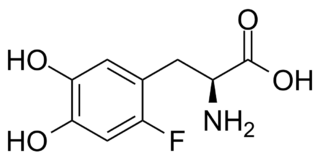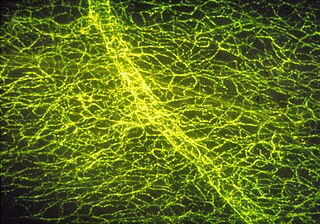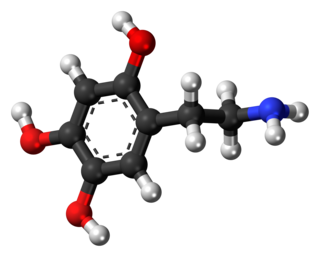 W
WA catecholamine is a monoamine neurotransmitter, an organic compound that has a catechol and a side-chain amine.
 W
WAdrenaline, also known as epinephrine, is a hormone and medication. Adrenaline is normally produced by both the adrenal glands and a small number of neurons in the medulla oblongata, where it acts as a neurotransmitter involved in regulating visceral functions. It plays an important role in the fight-or-flight response by increasing blood flow to muscles, output of the heart, pupil dilation response and blood sugar level. It does this by binding to alpha and beta receptors. It is found in many animals and some single-celled organisms. Polish physiologist Napoleon Cybulski first isolated adrenaline in 1895.
 W
WAdrenalone is an adrenergic agonist used as a topical vasoconstrictor and hemostatic. Formerly, it was also used to prolong the action of local anesthetics. It is the ketone form of epinephrine (adrenaline). Contrary to epinephrine, adrenalone mainly acts on alpha-1 adrenergic receptors, but has little affinity for beta receptors. The drug is largely obsolete, being superseded by other hemostatics such as thrombin, fibrinogen, and vasopressin analogues.
 W
WCarbidopa (Lodosyn) is a drug given to people with Parkinson's disease in order to inhibit peripheral metabolism of levodopa. This property is significant in that it allows a greater proportion of peripheral levodopa to cross the blood–brain barrier for central nervous system effect.
 W
WCorbadrine, also known as levonordefrin (USAN) and α-methylnorepinephrine, is a catecholamine sympathomimetic used as a topical nasal decongestant and vasoconstrictor in dentistry in the United States,.
 W
WCysteinyldopa is a catecholamine. Excessive cysteinyldopa in plasma and urine has been linked to malignant melanoma. Cysteinyldopa is found in large amounts in the plasma and urine of patients with malignant melanoma. It is therefore used in the diagnosis of melanoma and for the detection of postoperative metastases. Cysteinyldopa is believed to be formed by the rapid enzymatic hydrolysis of 5-S-glutathionedopa found in melanin-producing cells.
 W
WDeoxyepinephrine, also known by the common names N-methyldopamine and epinine, is an organic compound and natural product that is structurally related to the important neurotransmitters dopamine and epinephrine. All three of these compounds also belong to the catecholamine family. The pharmacology of epinine largely resembles that of its "parent", dopamine. Epinine has been found in plants, insects and animals. It is also of significance as the active metabolic breakdown product of the prodrug ibopamine, which has been used to treat congestive heart failure.
 W
Wα-Difluoromethyl-DOPA is a DOPA decarboxylase inhibitor.
 W
WN,N-Dimethyldopamine (DMDA) is an organic compound belonging to the phenethylamine family. It is related structurally to the alkaloid epinine (N-methyldopamine) and to the major neurotransmitter dopamine. Because of its structural relationship to dopamine, DMDA has been the subject of a number of pharmacological investigations. DMDA has been detected in Acacia rigidula.
 W
WDipivefrine (INN) or dipivefrin (USAN), trade name Propine among others, is a prodrug of epinephrine, and is used to treat open-angle glaucoma. It is available as a 0.1% ophthalmic solution. It is no longer available in the United States.
 W
Wd-DOPA is similar to l-DOPA (levodopa), but with opposite chirality. Levo- and dextro- rotation refer to a molecule's ability to rotate planes of polarized light in either direction. Whereas l-DOPA is moderately effective in the treatment of Parkinson's disease (PD) and Dopamine-responsive dystonia (DRD) by stimulating the production of dopamine in the brain, d-DOPA is biologically inactive.
 W
Wl-DOPA, also known as levodopa and l-3,4-dihydroxyphenylalanine, is an amino acid that is made and used as part of the normal biology of humans, as well as some animals and plants. Humans, as well as a portion of the other animals that utilize l-DOPA in their biology, make it via biosynthesis from the amino acid l-tyrosine. l-DOPA is the precursor to the neurotransmitters dopamine, norepinephrine (noradrenaline), and epinephrine (adrenaline), which are collectively known as catecholamines. Furthermore, l-DOPA itself mediates neurotrophic factor release by the brain and CNS. l-DOPA can be manufactured and in its pure form is sold as a psychoactive drug with the INN levodopa; trade names include Sinemet, Pharmacopa, Atamet, and Stalevo. As a drug, it is used in the clinical treatment of Parkinson's disease and dopamine-responsive dystonia.
 W
WDopamine is a hormone and a neurotransmitter that plays several important roles in the brain and body. It is an organic chemical of the catecholamine and phenethylamine families. Dopamine constitutes about 80% of the catecholamine content in the brain. It is an amine synthesized by removing a carboxyl group from a molecule of its precursor chemical L-DOPA, which is synthesized in the brain and kidneys. Dopamine is also synthesized in plants and most animals. In the brain, dopamine functions as a neurotransmitter—a chemical released by neurons to send signals to other nerve cells. The brain includes several distinct dopamine pathways, one of which plays a major role in the motivational component of reward-motivated behavior. The anticipation of most types of rewards increases the level of dopamine in the brain, and many addictive drugs increase dopamine release or block its reuptake into neurons following release. Other brain dopamine pathways are involved in motor control and in controlling the release of various hormones. These pathways and cell groups form a dopamine system which is neuromodulatory.
 W
Wl-Dopaquinone also known as o-dopaquinone is a metabolite of L-DOPA (L-dihydroxyphenylalanine) and a precursor of melanin.
 W
WDopexamine is a synthetic analogue of dopamine that is administered intravenously in hospitals to reduce exacerbations of heart failure and to treat heart failure following cardiac surgery. It is not used often, as more established drugs like epinephrine, dopamine, dobutamine, norepinephrine, and levosimendan work as well. It works by stimulating beta-2 adrenergic receptors and peripheral dopamine receptor D1 and dopamine receptor D2. It also inhibits the neuronal re-uptake of norepinephrine.
 W
WDroxidopa is a synthetic amino acid precursor which acts as a prodrug to the neurotransmitter norepinephrine (noradrenaline). Unlike norepinephrine, droxidopa is capable of crossing the protective blood–brain barrier (BBB).
 W
WEthylnorepinephrine is a sympathomimetic and bronchodilator related to norepinephrine. It activates both α and β adrenergic receptors.
 W
WEtilevodopa (TV-1203) is a dopaminergic agent which was developed as a treatment for Parkinson's disease. It is the ethyl ester of levodopa. It was never marketed.
 W
WFluorodopa, also known as FDOPA, is a fluorinated form of L-DOPA primarily synthesized as its fluorine-18 isotopologue for use as a radiotracer in positron emission tomography (PET).
 W
W6-Fluoronorepinephrine (6-FNE) is a selective α1 and α2 adrenergic receptor full agonist related to norepinephrine. It is the only selective full agonist for the α adrenergic receptors known to date and has been used to study their function in scientific research. Infusion of 6-FNE into the locus coeruleus of rodents produces marked hyperactivity and behavioral disinhibition by suppressing activity in the area via stimulation of α1 adrenergic receptors.
 W
WHexoprenaline is a selective β2 adrenergic receptor agonist used in the treatment of asthma. Hexoprenaline is also used in some countries as a tocolytic agent, with the most common trade name being Gynipral. It is not approved by U.S. FDA.
 W
WThe catecholamines comprise the endogenous substances dopamine, noradrenaline (norepinephrine) and adrenaline (epinephrine) as well as numerous artificially synthesized compounds such as isoprenaline. Their investigation constitutes a prominent chapter in the history of physiology, biochemistry and pharmacology. Adrenaline was the first hormone extracted from its endocrine gland and obtained in pure form, before the word hormone was coined. It was also the first hormone the structure and biosynthesis of which were clarified. Apart from acetylcholine, adrenaline and noradrenaline were the first neurotransmitters to be discovered and the first intercellular biochemical signals to be found in intracellular vesicles. The β-adrenoceptor was the first G protein-coupled receptor the gene of which was cloned. Goal-directed catecholamine research began with the preparation by George Oliver and Edward Albert Sharpey-Schafer of a pharmacologically active extract from the adrenal glands.
 W
WIsoetarine is a selective short-acting β2 adrenoreceptor agonist. It can be called the "granddaughter of adrenalin" in the line of β2 agonists that gave quick relief for bronchospasm and asthma. Epinephrine (adrenalin) was the first of these, and next came isoprenaline (isoproterenol). Isoetharine was the third drug in this line, thus the third generation or granddaughter of the original.
 W
WIsoprenaline, or isoproterenol, is a medication used for the treatment of bradycardia, heart block, and rarely for asthma. It is a non-selective β adrenoreceptor agonist that is the isopropylamine analog of epinephrine (adrenaline).
 W
WMelevodopa is a dopaminergic agent. It is the methyl ester of levodopa. It is used in tablet form as an effervescent prodrug with 250 times the water solubility of tablet levodopa.
 W
WMethyldopa, sold under the brand name Aldomet among others, is a medication used for high blood pressure. It is one of the preferred treatments for high blood pressure in pregnancy. For other types of high blood pressure including very high blood pressure resulting in symptoms other medications are typically preferred. It can be given by mouth or injection into a vein. Onset of effects is around 5 hours and they last about a day.
 W
W3-O-Methyldopa (3-OMD) is one of the most important metabolites of L-DOPA, a drug used in the treatment of the Parkinson's disease.
 W
Wα-Methyldopamine (α-Me-DA), also known as 3,4-dihydroxyamphetamine, is a research chemical of the catecholamine and amphetamine chemical classes. Its bis-glutathionyl metabolite is slightly neurotoxic when directly injected into the brain's ventricles.
 W
WNorepinephrine (NE), also called noradrenaline (NA) or noradrenalin, is an organic chemical in the catecholamine family that functions in the brain and body as a hormone and neurotransmitter. The name "noradrenaline", derived from Latin roots meaning "at/alongside the kidneys", is more commonly used in the United Kingdom; in the United States, "norepinephrine", derived from Greek roots having that same meaning, is usually preferred. "Norepinephrine" is also the international nonproprietary name given to the drug. Regardless of which name is used for the substance itself, parts of the body that produce or are affected by it are referred to as noradrenergic.
 W
WOxidopamine, also known as 6-hydroxydopamine (6-OHDA) or 2,4,5-trihydroxyphenethylamine, is a neurotoxic synthetic organic compound used by researchers to selectively destroy dopaminergic and noradrenergic neurons in the brain. 6-OHDA is thought to enter the neurons via the dopamine and noradrenaline (norepinephrine) reuptake transporters. Oxidopamine is often used in conjunction with a selective noradrenaline reuptake inhibitor to selectively destroy dopaminergic neurons.
 W
WRimiterol (INN/USAN) is a third-generation short-acting β2 agonist.
 W
WTheodrenaline (INN), also known as noradrenalinoethyltheophylline, is a chemical linkage of norepinephrine (noradrenaline) and theophylline used as a cardiac stimulant.